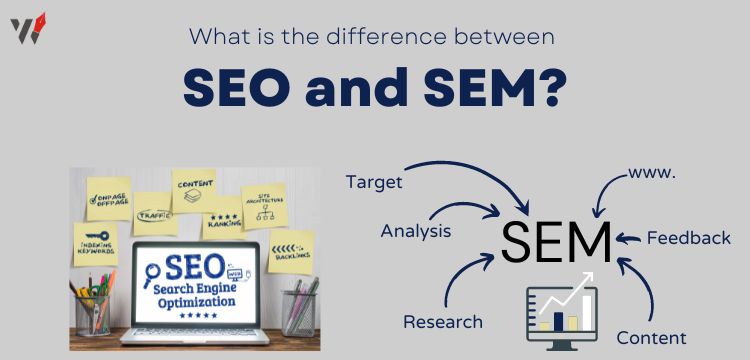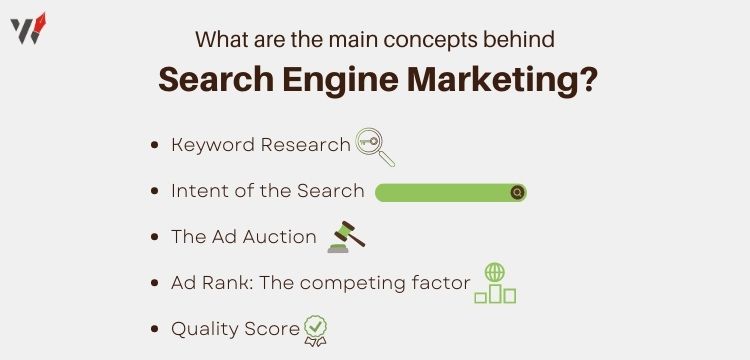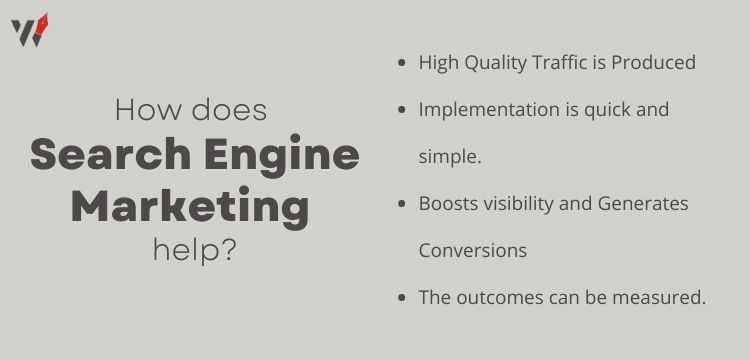What if there was a way to improve the results of your marketing efforts? What if you could maximize the value of every dollar you invest in paid search? Do you want to get a leg up on your rivals? Afterward, keep reading.
Digital marketing channels like search engine marketing are incredibly successful. You can use both paid and free strategies to boost the exposure of your website through search marketing.
SEM is crucial since search traffic is more valuable and focused than any other type of traffic you may obtain through other advertising channels.
Search engine marketing is the most efficient approach to market your items and expand your business because there are millions of businesses competing for the same consumers’ attention online.
Table of Contents
But, what is SEM?
The technique of marketing a company through paid adverts that display on search engine results pages (or SERPs) is known as “search engine marketing”. Advertisers place bids on terms that customers of search engines like Google and Bing would use when looking for specific goods or services, giving them the chance for their adverts to show up alongside search results for those keywords.
Read more about Keywords: Effective Keyword Research methods for a website blog
These advertisements, also referred to as pay-per-click advertisements, come in a variety of formats. Some are brief, text-based adverts, while others, like product listing ads (PLAs, sometimes called shopping ads), are more visual, product-based marketing that let customers see key details, such pricing and reviews, quickly.
The biggest advantage of search engine marketing is that it gives businesses the chance to display their adverts in front of motivated consumers who are prepared to buy at the exact moment those consumers are prepared to do so. Search engine marketing is so effective and such an extraordinarily strong approach to expand your business since no other advertising medium can achieve this.
What is the difference between SEO and SEM?

It’s challenging to prevent ambiguity when discussing the distinctions between SEO and SEM. The marketing of your website through organic means and sponsored media, such as PPC ads, may help it rise to the top of the search engine results page (SERP). SEO has long been thought of as an organic kind of advertising, however SEM has seen a shift in perception.
SEM initially referred to both paid and organic tactics. In this instance, SEO is seen as a component of SEM. SEM and SEO fall into different categories now that advertisers increasingly only refer to sponsored operations when using the term “search engine marketing.”
What are the main concepts behind Search Engine Marketing?

Google’s SERP may display paid advertisements above organic results.
Such a prominent location is probably going to produce results, but to get the most out of your paid advertisements, you need to understand your target market and produce material that is pertinent to them. Without some preparation, SEM cannot operate effectively. In reality, the goal of effective search marketing is to connect with users at the precise moment they are ready to make a purchase.
Keyword Research
Keywords are the phrases users type into search engines to cause a specific advertisement or search result to be shown. They don’t need to be separate terms. The use of phrases like “purchase Nike sneakers” or “what is the greatest accounting software” is actually rather prevalent.
Read more about Keyword Research: BEST KEYWORD RESEARCH TOOLS
This is where the overlap between SEM and SEO becomes apparent: the core of search engine marketing are keywords. The significance of thorough keyword research for the achievement of your paid advertising plan cannot be overstated. An effective SEM plan is a great addition to an already potent SEO approach if you want to dominate the SERPs.
Intent of the Search
It’s crucial that you spend some time with your keywords and truly understand them before you begin developing your advertisement.
Sometimes, users enter search queries with a very specific goal in mind. When compared to people who are just “surfing” the internet for entertainment, individuals who seek information of a commercial nature are much more likely to make a purchase at the end of their search.
Essentially, Search intent describes the purpose with which the user is entering a search query.As a search engine, Google’s main work is to take users to results that are closest and satisfy this search query and give the user the relevant result.
The Ad Auction
Larger advertising budgets can undoubtedly be helpful, especially when focusing on highly competitive keywords, but they are by no means a prerequisite for success with search engine marketing. This is due to the fact that all advertisements must first pass through an ad auction procedure before showing up alongside search results.
Every time a user types a search query into Google, the ad auction process begins. Advertisers choose the keywords they wish to bid on and specify the amount (per click) they are ready to pay to have their ads show next to results for those keywords in order to be included in the ad auction. Your ads are entered into the ad auction if Google determines that the keywords you have placed a bid on are present in a user’s search query.
AdRank: The competing factor
Not every advertisement will show up for every search. This is because not every search has sufficient commercial intent to warrant displaying advertising next to results, and because the ad auction considers a number of factors when choosing the placement of ads on the SERP. However, your highest offer and the Quality Score of your advertising are the two key elements that Google considers while conducting the ad auction process.
The maximum bid is the most you’ve specified you’re willing to shell out for a click. A metric based on the overall quality of your advertisement is called a quality score. Google uses these variables to determine where to display advertising during the ad auction. Ad rank is obtained as a result of this calculation.
Quality Score
One of the most important indicators search engine marketers may pay attention to is the Quality Score of Google AdWords, which makes up half of the algorithm for determining how ads rank. Due to Google’s preference for ads that are extremely relevant to user searches, high Quality Scores can assist you in obtaining higher ad positions at reduced costs.
Possibly the most significant metric in search engine marketing is Quality Score.
How does Search Engine Marketing help?

People who are at the end of the buying cycle conduct 90% of online searches.
If done correctly, SEM will place your adverts in front of your target audience along with information that is extremely relevant to them up until they click on your ad, all for free.
Your advertisement will appear on a search engine’s result page’s sponsored area when you use SEM. It is rated according to how much you pay for keywords and a “quality score” that measures how pertinent your ad is in comparison to others.
Search engine optimization (SEO) raises your site’s position in the meanwhile, causing it to appear higher in unpaid, organic search results.
People who are at the end of the buying cycle conduct 90% of online searches.
Utilizing SEM and SEO together will boost website traffic in addition to increasing the exposure of your adverts. Additionally, this boosts your probability of turning visitors into leads, particularly if your website and sponsored advertisements rank high in search engine rankings.
While SEO takes time to develop, SEM can be completed rapidly and has several advantages for your company.
High Quality Traffic is Produced
Organic traffic generation can be a very time-consuming, laborious procedure with long-term consequences. You can speed up this procedure and draw visitors to your website right away with search engine marketing. Additionally, because these users looked for what you have to give, you can be confident that they are interested in what you have to offer.
Implementation is quick and simple.
A SEM campaign can be quickly and easily set up. A campaign is highly versatile and adaptable and can be put up in a few hours, however it can take some time before you see the full impact.
Immediate adjustments can be made, allowing you to adjust your website’s content, keywords, and spending to match the actions of your target audience.
Boosts visibility and Generates Conversions
The main objectives of Google Ads and other search engine marketing tools are to enhance business performance and visibility.
Create optimized landing pages that guide users toward conversion in order to do this.
Even if a customer does not click on your brand the first time they see it, showing up in the top results of Google and other search engines links your brand with a certain demand.
The outcomes can be measured.
Solutions for search engine marketing, like Google Ads, offer a variety of metrics on campaigns and keep you updated at all times. This makes it very simple to alter the route if necessary and achieve better outcomes.
SEM, or search engine marketing, offers a tremendous deal of promise to assist businesses in quickly and effectively achieving their objectives. It is crucial to have professionals with considerable experience situating companies in Google so that you can get the most out of it.
Read blog about Marketing Research and its Assistance: What Is Marketing Research And Its Assistance
Conclusion
Hyper-targeted ad copy and a high ROI, in essence, are what make an advertisement effective. By better comprehending your target audience, you can ensure that your advertisement is displayed to them as soon as they enter the appropriate stage of the buying funnel.
An efficient ad campaign is an essential component of a comprehensive SEM strategy since it presents your company’s offer in the appropriate location and at the appropriate time. But that’s not all; SEM is a fantastic approach to increase brand awareness while also driving traffic to your website.
Frequently Asked Questions
- What are the three types of search engine marketing?
The most common kinds of search engine marketing are as follows:
- Pay per Click (PPC)
- Local SEO.
- Organic SEO.
- What is a Quality Score?
One of the most important indicators search engine marketers may pay attention to is the Quality Score of Google AdWords, which makes up half of the algorithm for determining how ads rank. Due to Google’s preference for ads that are extremely relevant to user searches, high Quality Scores can assist you in obtaining higher ad positions at reduced costs.
- What are the benefits of SEM?
The main benefits of employing SEM strategies are:
- High Quality Traffic is Produced
- Implementation is quick and simple
- Boosts visibility and Generates Conversions
- The outcomes can be measured.
- Is Google Ads SEO or SEM?
Paid SEM includes PPC advertisements on Google, Bing, and other search engines. Real-time auction is used by the majority of advertising firms, including Google Ads. It’s essential to consider how the advertising platform you select conducts its ad auctions.
- What are the types of digital marketing?
There are a number of widely used techniques for carrying out digital marketing, such as:
- Search Engine Optimization (SEO)
- Search Engine Marketing (SEM)
- Pay-Per-Click (PPC)
- Social Media Marketing (SMM)
- Email marketing
- Affiliate marketing
- Native advertising


 WhatsApp
WhatsApp